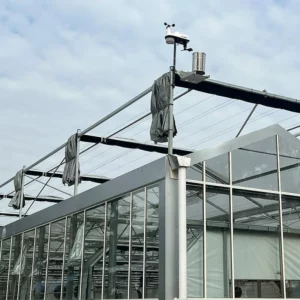Blackout greenhouses offer specific advantages in comparison to other cultivation systems, especially when it comes to controlling light exposure.
Here are some advantages of using blackout greenhouses:
- Light Control:
- Blackout greenhouses provide complete control over light exposure to plants. This is crucial for certain crops that require specific day-length conditions for flowering and fruiting. The blackout system allows growers to manipulate photoperiods, enhancing crop quality and yield.
- Light Deprivation:
- The blackout system in these greenhouses enables light deprivation, a technique used to induce flowering in certain plants. By manipulating the duration of light exposure, growers can trigger flowering and control the growth cycle of crops, allowing for more flexible cultivation schedules.
- Year-Round Production:
- Blackout greenhouses extend the growing season and enable year-round production. By controlling natural light cycles, growers can provide a consistent and controlled environment, overcoming seasonal limitations and maximizing crop yields.
- Enhanced Crop Quality:
- Precise control over light exposure contributes to improved crop quality. This is particularly important for high-value crops, where factors such as color, size, and flavor are critical. Blackout greenhouses allow for the optimization of these attributes.
- Reduced Energy Costs:
- While blackout greenhouses require supplemental lighting during periods of light deprivation, the controlled environment they provide can lead to energy savings in terms of heating and cooling requirements. The enclosed structure helps retain temperature, reducing energy costs associated with maintaining optimal growing conditions.
- Pest and Disease Control:
- The enclosed nature of blackout greenhouses provides a level of protection against pests and diseases. China Blackout Greenhouse supplier The controlled environment minimizes the entry of external pathogens, reducing the need for chemical interventions and promoting healthier crops.
- Climate Control:
- Blackout greenhouses often come equipped with advanced climate control systems. This includes ventilation, heating, and cooling systems that can be precisely adjusted to create an optimal environment for plant growth.
- Water Efficiency:
- With controlled environments, blackout greenhouses allow for efficient water management through technologies like drip irrigation and hydroponic systems. This contributes to water conservation and sustainable agricultural practices.
- Vertical Farming Potential:
- Blackout greenhouses can be designed to facilitate vertical farming practices. This maximizes space utilization, making them suitable for urban agriculture or areas with limited available land.
- Crop Rotation and Multiple Crops:
- The flexibility of blackout greenhouses allows for easy crop rotation and the cultivation of multiple crops within the same structure. This versatility supports diversified farming practices and provides economic benefits.
- Reduced Light Pollution:
- The blackout system minimizes light pollution, making blackout greenhouses suitable for urban or residential areas. This can be particularly advantageous when compared to outdoor cultivation or traditional greenhouse setups.
It’s important to note that the advantages of blackout greenhouses are particularly relevant for certain crops and production goals. The choice of cultivation system depends on factors such as the type of crops grown, market demand, available resources, and the specific goals of the grower.
